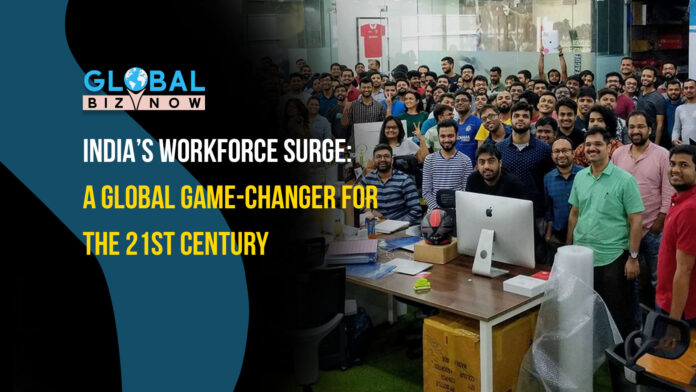Against demographic changes and uncertain economic settings, one nation is very well placed to lead change towards a bright future that India is to be – the country would add close to 20% growth of the world’s global workforce by 2050 – by the estimates from Angel One Wealth. At the same time, long proclaimed as the factory of the world, China will shrink its labor force further while India is young, energetic, and full of energy. Thus, all the changes going to impact labor force dynamics will shape Indian global growth, making this a prime player in the worldwide economy.
India’s Workforce Advantage: The Numbers Speak
The projections are clear and transformative:
India’s working-age population (15–64 years old) is predicted to increase by more than 220 million between 2023 and 2050.
According to UN estimates, India will have more than 1 billion people of working age by 2050, making it the country with the largest working-age population in the world.
It indicates a serious reallocation of economic power between these two Asian giants for the next decades
Why is this taking place?
Demographic Dividend: China’s median age in 2023 was 39 years old, while India’s median age was 28 years old, making it a younger nation. India benefits from a greater fertility rate and a younger demographic profile, whereas China’s population is aging as a result of decades of the one-child policy.
Economic Reforms: The GST, the Pradhan Mantri Jan Dhan Yojana, and the push for digital payments are just a few of the structural changes that have made India’s economy more inclusive.
Emphasis on Education and Skilling: Skills India and National Education Policy provide a platform to the young generation in shaping a globalized economy, enhancing employability in several sectors, such as IT, healthcare, and advanced manufacturing.
Low Household Debt and Rise in Incomes: India’s household debt-to-GDP ratio remains at 37%, much less than that of China’s 61%. This increases consumer spending and economic activity, as does the expanding middle class and rising per capita income, which is expected to reach $3,500 by 2030.
Center for International Innovation and Outsourcing: With 55% of global IT outsourcing in 2023 coming from the nation, its standing as a center for IT and information services only grows. With the rise of sectors like biotechnology, finance, and artificial intelligence, this guarantees that the labor force remains globally competitive.
Economic Growth: India’s GDP is directly boosted by the country’s workforce growth rate. With this, India’s economy is expected to develop at a yearly rate of between 6–7%, making it the third largest economy by 2030.A significant young workforce will ensure an unprecedented level of productivity, helping fuel industrial output, services, and exports.
Global Supply of Labor: As the advanced economies such as Japan, Europe, and even China face labor shortages because of aging populations, India will be a very important source of skilled and unskilled labor. This will fill up the gaps in the global workforce while increasing remittances, which stood at $111 billion in 2023.
Encouragement of Domestic Innovation: Innovation is fueled by a youthful, tech-savvy workforce. Startups in sectors including edtech, healthtech, and agritech are thriving because of government initiatives and venture capital funding.
Changing Global Trade Dynamics: India’s population advantage positions it as a replacement for China in global supply chains. Manufacturing is increasingly moving to India in sectors including electronics, medicines, and textiles.
The Comparison of China and India
Despite China’s unparalleled rise over the past three decades, its growth model is becoming more and more flawed.
Aging Population: In 2022, China’s population peaked and its fertility rate dropped to 1.2, much lower than the replacement rate of 2.1. At a fertility rate of 2.0, India’s working-age population continues to increase.
Economic Growth Plateau: India is achieving remarkable 6-7% growth, whereas China’s growth has slowed to 4-5% yearly.
Manufacturing Shift: India is seen emerging as the new hub for manufacturing because of initiatives like Make in India and production-linked incentives (PLI) schemes.
Issues India Must Address
Though workforce surge is a gigantic opportunity, it comes with challenges of
Employment Generation: For 220 million new jobs by 2050, policies must be robust; industrial expansion must happen along with infrastructure investment.
Gender Inequality: India’s female labor force participation rate stands at only 23%. This can go higher and increase output levels.
Quality Education: Providing universal access to quality education and skill development programs will be essential in fully exploiting the demographic dividend.
India’s Moment on the World Arena
India is poised for a transformative era that will drive economic advancement both domestically and internationally, thanks to its growing labor force. With a young population, rising incomes, and low debt levels, India is well-positioned to reap the benefits of its demographic dividend.
But responsibility comes along with the opportunity. To provide the workforce with skills, generate employment, and guarantee inclusive growth, the public and commercial sectors as well as educational institutions must collaborate. If properly handled, India’s labor boom would not only transform its own economy but also the global labor market, securing its place as a major force behind advancement in the twenty-first century.
India’s tale is full of possibility and promise in a world where many countries are struggling due to demographic shifts. By embracing this opportunity, India can not only lead its people to prosperity but also contribute meaningfully to the global economy for decades to come.

